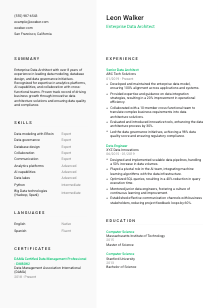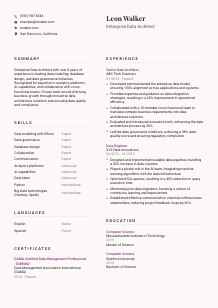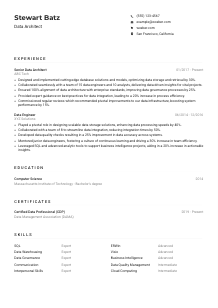Enterprise Data Architect CV Example
Designing data landscapes, but your CV feels like a jumbled schema? Navigate this Enterprise Data Architect CV example, structured with Wozber free CV builder. Grasp how to blueprint your data expertise to align with enterprise needs, crafting a career narrative as robust and agile as your database solutions!

How to write an Enterprise Data Architect CV?
Hello, aspiring Enterprise Data Architect! If you're aiming to stand out in the ever-evolving realm of data architecture, you understand the necessity of a CV that doesn't just 'fit in' but takes charge. With the precision of a well-designed data model, your CV should reflect your profound expertise and ambition.
Utilizing the free CV builder, Wozber, we're diving deep into the process of tailoring your CV, making it ATS-compliant, and ensuring it speaks directly to the heart of your dream role. Let's embark on this mission to carve out a CV that maps your career trajectory with clarity and impact.
Personal Details
Your personal details section is more than just the header of your CV; it's the beacon that guides the hiring manager to your doorstep. Let's navigate through crafting this section specifically for the Enterprise Data Architect role, ensuring precision and alignment with the job at hand.
1. Brand Yourself Boldly
Begin with your name, making sure it stands distinguished and commands attention in a clear, professionally styled font.
2. Position with Precision
Directly beneath your name, align your ambition by denoting yourself as an "Enterprise Data Architect". This primes the reader instantly on your professional focus.
3. Dial-In Your Details
Ensure your contact information is meticulously accurate – a reachable phone number and a professional email address are non-negotiable. Double-check for typos! This signals your attention to detail, an indispensable trait for an Enterprise Data Architect.
4. Location, Location, Location
Given the mandate for a San Francisco, California location, including this upfront addresses one of the key logistical checks right off the bat. It's a green signal for local recruitment.
5. A Digital Footprint
If you have a LinkedIn profile or a personal portfolio website showcasing your projects and achievements, don't hesitate to include it. It's a window for your potential employer to see your professional prowess in action.
Takeaway
Your personal details are not just formalities; they are your first handshake with your potential employer. Craft this section with care, ensuring it stands as a paragon of professional dedication and alignment with the Enterprise Data Architect role.





Experience
The experience section is the powerhouse of your CV, a comprehensive map detailing the territories you've conquered. Tailoring this section for an Enterprise Data Architect position demands strategic alignment with the job requirements.
- Developed and maintained the enterprise data model, ensuring 100% alignment across applications and systems.
- Provided expertise and guidance on data integration strategies, resulting in a 20% improvement in operational efficiency.
- Collaborated with a 10‑member cross‑functional team to translate complex business requirements into data architecture solutions.
- Evaluated and introduced innovative tools, enhancing the data architecture process by 30%.
- Led the data governance initiatives, achieving a 98% data quality score and ensuring regulatory compliance.
- Designed and implemented scalable data pipelines, handling a 50% increase in data volumes.
- Played a pivotal role in the AI team, integrating machine learning algorithms with the data infrastructure.
- Optimised SQL queries, resulting in a 40% reduction in query execution time.
- Mentored junior data engineers, fostering a culture of continuous learning and improvement.
- Established effective communication channels with business stakeholders, reducing project feedback loops by 60%.
1. Dissect the Job Description
Isolate each requirement detailed in the job description. For instance, the call for experience in data governance and analytics platforms is your cue to highlight these experiences prominently.
2. Lay Out Your Professional Journey
Outline your roles in reverse chronological order, ensuring each position includes the job title, company name, and employment duration. This clarity and organisation make it easier for the hiring manager to navigate your career path.
3. Showcase Your Architectural Achievements
In each role, spotlight your accomplishments that speak directly to the job requirements. Demonstrate how your guidance in data integration led to operational efficiency improvements or how your leadership in data governance initiatives advanced data quality standards.
4. Numbers Speak Louder
Quantifying your achievements, such as 'improving operational efficiency by 20%' or 'achieving a 98% data quality score', paints a vivid picture of your impact. This evidence-based approach is persuasive and powerful.
5. Relevance is Key
Concentrate on experiences that resonate with the Enterprise Data Architect's responsibilities. Extraneous information dilutes your message. Keep your aim true and focused.
Takeaway
Use the experience section to narrate your journey in data architecture, showcasing your strategic contributions and achievements. Let each bullet point serve as testament to your capability to thrive in the Enterprise Data Architect role. Your CV is more than a document; it's the story of your professional journey.
Education
While seemingly straightforward, the education section of your CV is a cornerstone, displaying the foundational knowledge upon which you've built your career. Here's how to ensure it speaks volumes for your candidacy for the Enterprise Data Architect role.
1. Highlight the Essentials
Align your educational qualifications with the requirements – a Bachelor's or Master's degree in Computer Science or a related field is your ticket into the realm of data architecture.
2. A Model of Simplicity
Maintain clarity by listing your degree, the institution, and your graduation year. This straightforward structure makes it easy for hiring managers to verify your educational background.
3. Degree Details That Matter
In this competitive landscape, specifying your "Master of Science in Computer Science" directly matches you to the job's educational prerequisites, firmly establishing your credibility.
4. Special Subjects
Though not always necessary, mentioning key courses or projects related to data architecture can be beneficial, especially for those at the start of their career.
5. Celebrate Your Achievements
If there are any honors or extracurricular activities that underscore your commitment to this field, don't hesitate to include them. For senior roles, let your experience and degree speak for themselves.
Takeaway
Your education section is your professional foundation. Ensure it reflects not only your qualifications but also your commitment to the field of data architecture. It's here that your journey began, and it deserves to be highlighted with pride.
Certificates
In a field as dynamic as Enterprise Data Architecture, certifications serve as milestones of your continuous learning and expertise. Let's align this section with the job description to underscore your qualifications.
1. Align with Job Necessities
The job description seeks a "Certification in Data Management and Architecture", like the DAMA Certified Data Management Professional - DMBOK2. This credential should be your highlight.
2. Quality Over Quantity
Focus on listing certifications that directly enhance your candidacy for the Enterprise Data Architect role. Each certificate listed should reflect your dedication to excelling in this field.
3. Dates Matter
Clarifying when you obtained your certifications, especially recent ones, can emphasize your commitment to staying updated in the rapidly evolving tech landscape.
4. Keep Learning
The technological arena is ever-changing, necessitating ongoing education. Regularly update and acquire new certifications relevant to your career trajectory.
Takeaway
Certificates aren't just achievements; they are markers of your dedication and passion for growth and excellence in Enterprise Data Architecture. Position them as jewels in your CV, each reflecting your journey towards being an industry standout.
Skills
For an Enterprise Data Architect, the skills section is your arsenal, packed with the tools of your trade. It's crucial to curate this section carefully to communicate your mastery and versatility. Let's dive into aligning it with the job requirements in mind.
1. Distill the Essentials
Review the job description closely and identify both the hard skills (like "Data modeling with ERwin") and soft skills (such as "Collaboration" and "Communication") required for the role.
2. Highlight Your Expertise
Clearly list the skills where you excel, particularly those that resonate with the essential requirements of the role. Presenting yourself as an expert in key areas immediately draws the hiring manager's attention.
3. Order and Precision
Resist the temptation to list every skill you consider yourself proficient in. Focus on the ones most pertinent to the job, ensuring your list is crisp and to the point, allowing for instant comprehension of your capabilities.
Takeaway
Your skills section should shine as a beacon of your proficiency and readiness for the challenges of the Enterprise Data Architect role. It's your opportunity to demonstrate that not only do you have the requisite mastery but that you are continually enhancing it. This is where your technical prowess meets your soft skill agility; show them off with pride.
Languages
In our interconnected world, the ability to communicate across cultures and regions can be a distinct advantage. For an Enterprise Data Architect, it showcases versatility and adaptability. Let's tailor this section precisely to both the explicit and potentially advantageous language skills.
1. Understand Job Language requisites
First, note any language requirements specified in the job post, such as "Must have the capability to understand and speak English" and prioritize these in your CV.
2. Your Linguistic Portfolio
Starting with the must-have language, also list any additional languages you're proficient in. Your ability to navigate in multiple linguistic landscapes could open up broader opportunities within the organisation.
3. Honest Proficiency Levels
Be transparent about your level of proficiency in each language listed, using terms like 'Native', 'Fluent', 'Intermediate', and 'Basic' to provide a clear picture of your skills.
4. Consider the Role's Scope
While the job might primarily require English, additional language skills may bolster your CV, particularly in roles engaging with global teams or markets.
5. Continuous Learning
Remember, every new language learned is an additional mode of connection and understanding in our global society. Even if you feel your current proficiency is lacking, every step towards improvement is progress.
Takeaway
Your ability to communicate in multiple languages is more than just a skill; it's a bridge to cultures and a tool for fostering collaboration across borders. It underscores your adaptability and willingness to engage in a global dialogue. Let your languages section reflect the breadth of your communication landscape.
Summary
Your summary section is the narrative cornerstone of your CV. For an Enterprise Data Architect, it's the opportunity to distill your essence, highlighting your unique blend of skills and achievements. Here's how to ensure it draws the reader in, compelling them to delve deeper into your professional saga.
1. Crystalize the Job Essence
Begin by absorbing the core responsibilities and qualifications sought after in the job description. This understanding will inform the crafting of your summary.
2. Lead with Your Identity
Position yourself with confidence as an Enterprise Data Architect, drawing attention to your years of experience and specialized expertise in the field.
3. Showcase Your Crown Jewels
Mention your strongest qualifications, such as your proficiency in data modeling tools, your background in analytics and AI, and your track record of enhancing operational efficiency and data governance.
4. Brevity with Impact
Ensure your summary is concise yet compelling. This isn't the place for exhaustive details but rather a teaser that invites the hiring manager to delve into the specifics on the following pages.
Takeaway
Craft your summary as if it were the opening lines of a gripping narrative, drawing the reader in with a glimpse of your story's depth and breadth. As an Enterprise Data Architect, you are not just a candidate but the architect of your career journey. Use this space to shine, paving the way for your next role.
Embarking on Your Enterprise Data Architect Odyssey
With these tailored insights, your CV is now a beacon, guiding you towards your next opportunity in the realm of Enterprise Data Architecture. Through thoughtful alignment with job requirements, strategic presentation of your qualifications, and making use of Wozber's free CV builder, including ATS-compliant CV formats and ATS-friendly CV templates, you've crafted a document that not only passes through ATS filters with ease but captivates the human eye. So, set forth with confidence. Your journey as an Enterprise Data Architect is poised for its next landmark achievement.
The world is waiting for your visionary impact. Launch your CV into orbit, and let's architect the future, one data model at a time.

- Bachelor's or Master's degree in Computer Science, Information Systems, or a related field.
- Minimum of 8 years of experience in data modeling, database design, and data governance.
- Proficiency in data modeling tools such as ER Studio or ERwin.
- Strong understanding of analytics platforms, data lakes, and AI capabilities.
- Excellent communication and collaboration skills, with the ability to translate complex technical terms to non-technical stakeholders.
- Certification in Data Management and Architecture (e.g., DAMA Certified Data Management Professional - DMBOK2).
- Must have the capability to understand and speak English.
- Mandatory location requirement: Must be located in San Francisco, California.
- Develop and maintain the enterprise data model, ensuring alignment across applications, systems, and data platforms.
- Provide expertise and guidance on data architecture, data integration, and data quality strategies to support business growth.
- Collaborate with cross-functional teams to understand business requirements and translate them into data architecture solutions.
- Evaluate and recommend new tools, techniques, and methodologies to enhance the data architecture and data governance processes.
- Lead the data governance and data stewardship initiatives, ensuring data quality and compliance with regulatory standards.















